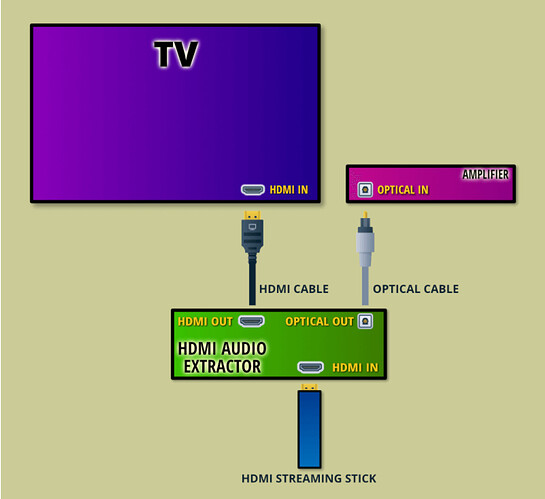Nowadays, most home theatre devices connect to one another via HDMI for better audio and video quality. Unfortunately, not every TV or A/V device has built-in speakers which is why you can’t play sound through HDMI cable.
That’s where the HDMI to audio extractor comes in! This gadget splits the audio and video signal from an HDMI source and enables you to have your video data and audio data on two separated RCA cables.
What is an HDMI Audio Extractor?
We all know that an HDMI cable can be connected to a wide range of devices — TVs, soundbars, consoles, streaming devices, and more. So, how does an HDMI audio extractor relate to all of this?
Say you have a vintage stereo that doesn’t have any HDMI ports, or you need a device that separates the video and audio signals transmitted by an HDMI cable because the sound setup just doesn’t receive video, you’re going to need an HDMI audio extractor.
An HDMI audio extractor is a device that is used in your AV setup that splits your HDMI signal, which contains both video and audio signals. It allows you to separate and direct the audio signal into a new analog or digital source through analog audio jacks or a digital S/PDIF jack, so you can play that audio signal on a separate device.
How does an HDMI extractor work?
An HDMI audio extractor isolates the audio signal from an HDMI signal, then decrypt and recode it into another type of audio signal. The audio will be turned into a 2-channel stereo audio signal and a digital audio signal depending on whether the audio extractor has this capability.
Moreover, 5.1/7.1 Dolby digital surround sound, which is transmitted via the optical jack, can also be extracted using HDMI audio extractors. Usually, you can select which audio signal you would like to use via a mode switch.
Does an HDMI Audio Extractor Degrade Sound Quality?
An HDMI audio extractor shouldn’t degrade your audio quality. Because HDMI is a digital signal, it will remain roughly the same quality unless you degrade it. Things that will impact audio quality include the sample rate capabilities of the HDMI audio extractor, the version of HDMI your devices support, the length of the cable used to connect them.
Sample rate is the key factor. It is how often a device’s signal is received. The higher the sample rate, the more precisely the intermittent digital signal can emulate a smooth analog signal. If your audio extractor has a low sample rate, then the audio will not be of the highest quality, that is to say, you won’t be able to reproduce higher frequencies and the minor timbres in the sound will be slightly dulled.
The current HDMI version is 2.1, and since the inception of HDMI, we have had sample rates of up to 192KHz. The HDMI versions that come with an audio extractor should be equipped with HDMI 2.0, making it possible to handle the 7.1 Dolby digital surround sound sample rates without any issues.
However, remember that an audio extractor also sends an HDMI video signal. This can have some effect on the visual quality depending on the version of HDMI that your audio extractor supports.
Cable length is also the length of the signal path. When two HDMI-capable devices are connected, a digital handshake takes place during which information about the connection’s specifications is transmitted. One of these things is the sample rate.
The length of the cable between devices will affect how long it takes for the signal to get from the output to the input, even though the devices are rated to output at a specific sample rate.
When the devices engage in the handshake, the signal sent between them is timed by the internal clocks of the two devices which determines the sample rate that the two devices communicate at.
How to Choose a Good HDMI Audio Extractor
Analog signals are sensitive, so it’s best to choose the right device that protects this signal. Here are factors to consider when choosing an HDMI audio extractor.
Most HDMI audio extractors will just have one HDMI input port. If you have several devices you wish to connect, it’s best to choose an audio extractor that can be connected to the number of devices you have. That way, you can plug several HDMI cables simultaneously.
Check the output ports available on your HDMI audio extractor and make sure that the HDMI output is either an HDMI 2.0 or 2.1 output. This way, the cable can send digital video signals to high-resolution TVs without lowering the refresh rate.
Identify the distance between your signal source to the receiver, which helps you know how long a distance the audio extractor should be able to support. If your HDMI cable exceeds 50 feet, its signal starts to degrade.
Conclusion
With an HDMI audio extractor, you get the benefits of retaining the video signals from your HDMI cable while also converting the audio signal to a compatible signal for your audio setup. All you need to do is to find a reliable HDMI audio extractor with enough input and output ports to connect to all of your devices. AV Access 4KCVH2H is an HDMI 2.0 audio extractor with resolutions up to 4K@60Hz and HDCP 2.2. It can be used in any AV application, such as homes, offices, digital entertainment centers, control centers, conference rooms, schools and corporate training environments which need HDMI audio extraction.
Related articles:
